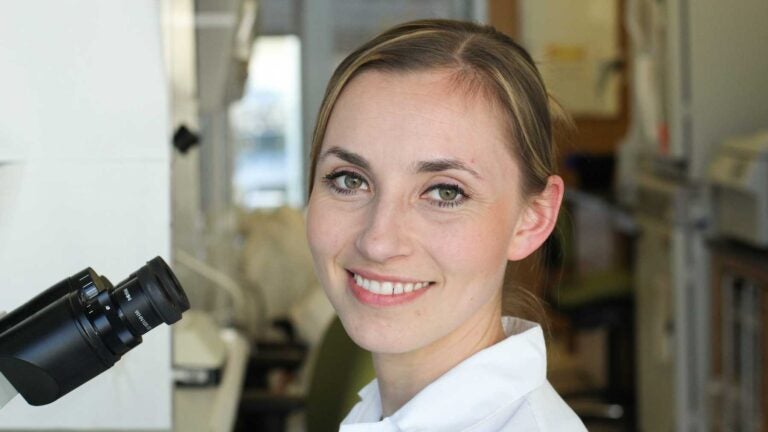
Kim Staats decided to study Amyotrophic Lateral Sclerosis, or ALS, after a childhood friend was diagnosed with the disease. (Photo/Cristy Lytal)
USC researcher looks for a pattern in ALS cases
Kim Staats is drawn to the clinical relevance of research in Justin Ichida’s lab, which explores ALS mechanisms
USC postdoctoral researcher Kim Staats found her calling when a childhood neighbor was diagnosed with ALS, a paralyzing and fatal neurodegenerative disease.
At the time, Staats was pursuing bachelor’s and master’s degrees in kinesiology at Free University Amsterdam (Vrije Universiteit Amsterdam), with plans to either practice or teach physical therapy after graduation.
As a kinesiology student, Staats asked herself: What if people with ALS do a lot more exercise? Would that give them a muscular buffer against this paralysis?
“I wrote a literature review on that, just for my courses, and realized very quickly that I couldn’t understand the system properly without understanding neurosciences better,” she said.
Determined to grasp ALS — which eventually claimed the life of her neighbor, his mother and brother — she undertook a second master’s degree in neurosciences at Free University Amsterdam.
After graduation, Staats, who is Canadian and Dutch, spent a year teaching English in Tokyo. She eventually chose to work on postdoctoral research in the lab of Justin Ichida at USC. She was drawn to the clinical relevance of the research in the Ichida Lab, which explores ALS mechanisms and screens therapeutic drug candidates using patient-derived motor nerve cells.
After arriving in the Ichida Lab, Staats was awarded a three-year, $180,000 development grant from the Muscular Dystrophy Association.
“I’m grateful for the MDA grant, which is truly enabling my ALS research at USC,” she said. “It is also a bit of a compliment, as it’s an honor to know that I can bring in grants sometimes, so at least there’s a reason I could believe I could be a principal investigator — a PI with my own lab someday.”
The chief symptom
With this support, she is exploring the causes for what is known as “sporadic” ALS, which occurs in people with no relatives known to have the disease.
In collaboration with fellow postdoctoral researcher Toru Sugawara, Staats has identified a candidate gene that might contribute to sporadic ALS. She is now working to clarify how a mutation in this gene might contribute to the death of motor nerve cells — the chief symptom of ALS. By studying the role of this gene, she aims to increase the understanding of not only what causes ALS, but also how to treat it.
“Ninety percent of all ALS patients, on average, are sporadic, and most of the work is being done on the familial cases because, of course, it’s easier. It’s genetic. We can fathom this,” Staats said. “So I really like the MDA project because it allows us to look at the sporadic component.”
In addition to challenging herself in the lab, Staats enjoys exploring Los Angeles — from the hiking trails in the mountains to cafes in downtown neighborhoods, including the Arts District and Little Tokyo. She also appreciates the city’s colorful history and lives in a converted hotel, built in 1927, in Koreatown.
“It has a penthouse on the roof in which Clark Gable lived,” she said. “It’s old-fashioned Hollywood. We have a mail chute that still works. And we have the first rooftop pool in all of L.A. It’s tiny. It’s not even heated. But it’s a historical part of L.A., and I love that.”
As for the future, whether she remains in L.A. or explores new opportunities abroad, Staats will remain devoted to the study of ALS and the quest for better treatments.
“ALS is one of the most devastating diseases someone can encounter or suffer from. There’s no cure available. There are two drugs currently available, but they only prolong the life of an ALS patient by a number of months,” she said. “That’s not enough.”
